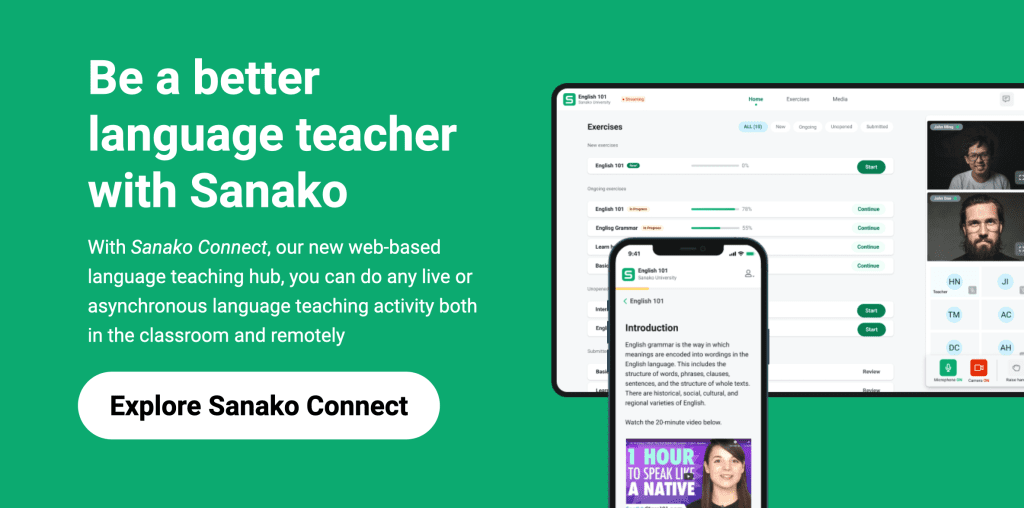For many language teachers, remote teaching represents the daily dimension of their work. While it is true that practice makes perfect and the need to work remotely during the pandemic has strengthened the digital skills of language teachers worldwide, it is also true that remote teaching is a specific form of teaching mode. It has its own rhythms, its own strategies. In this post, we want to help you think about the best ways to set up a quality remote language course.
Do you really know remote learning?
A computer, the interface of a teleconferencing platform flashing across the desktop, slide open on another tab, and pupils connected on the other side of the screen. The setting will sound familiar to many language teachers. But does remote language learning differ from face-to-face teaching only because pupils and teachers meet in a virtual space rather than in a classroom? For many schools, especially in the early days of the pandemic, remote teaching has been nothing more than a continuation of face-to-face teaching by other means.
In fact, as pointed out in a British Council paper, “remote language teaching requires more from the teacher than standard classroom teaching.” In a virtual classroom, the teacher has to perform the teaching activities, just as in a physical classroom, and to do this, they must ensure that they make the most of the technology available. Using chat, the share screen function, creating breakout rooms to organize group activities among students are necessary actions to realize a proper online lesson.
Finally, there are students to keep engaged which is not always an easy task.
The first step in achieving quality distance learning, therefore, is to reflect on online teaching as a distinctive model of teaching, and not just a simple transposition of face-to-face teaching on Sanako Connect, Zoom or Google Meet.
Here are some questions you can ask yourself to steer your planning about distance learning onto the right tracks:
- In what ways can the use of educational technology impact my pedagogical approach?
- What are the main features of the virtual platform on which the classes will take place? What kind of interactions between me and my pupils are possible through it (eg. synchronous vs asynchronous tasks)?
- Is my usual teaching material fit for a remote learning context? Should I design it differently?
Think of availability/accessibility
It doesn’t matter if you have the most advanced technology ever if your students find it challenging to access it.
The relationship between students and technology can be impaired by two factors:
Availability: the platform of choice might work only on desktops, it could be supported only by certain operating systems, or it might be too expensive, or requires an optimal internet connection to function.
Accessibility: the platform does not provide adequate support for students with learning disabilities. Among the basic accessibility features that a platform should have, there are text-to-speech assistive technology, speak screen, and immersive reading.
Here are some questions that can guide you in choosing the best distance teaching technology support for your students.
- Can my students easily access the platform and the digital learning resources that come with it?
- Does the platform I would like to adopt have an adequate customer support service that both my students and I can navigate?
- Is the platform easy to navigate? Technology must be at the service of teaching, so whatever software or platform you decide to use, it must allow students to use their energy and focus on mastering content, rather than mastering the technology itself.
Remote teaching and community-building
Communication between students and teachers is necessary for the successful outcome of the distance teaching process. Within a virtual context, accurately expressing expectations and setting housekeeping rules are equally important.
Within a virtual classroom, it’s important not only to clearly set instructional goals but also to establish rules of conduct so that taking refuge behind a switched-off camera doesn’t become an easy way out for bored students.
Therefore, you can create a space within the platform where you can save not only an updated version of the syllabus but also other useful resources. Think for instance of FAQs that include clarifications on netiquette, tips and tricks for an optimal setup in which to follow remote classes, email contacts in case of glitches in the didactic platform, etc.
In short, create dedicated spaces within the learning platforms to which students can return, periodically, to understand the course content but also the dynamics of communication and interaction within the virtual classroom.
Technology provides you with powerful tools to establish a common learning pathway with your students. Set goals, but also norms, and in this way, you would have built not just a remote classroom but an online learning community. We bet that the level of students’ engagement will be positively affected!
Looking for a guide on community building in online teaching? Check out some remote teaching good practices and tips from the below video.

What questions can guide your community-building plans? We believe that these questions can be a good starting point:
- Are the learning objectives for the course clearly stated in the syllabus?
- What kind of communication channels do I plan to have with my students? And how will I manage them?
- Do I have a strategy to keep students engaged?
To recap: in this post, we have proposed a series of key issues for you to think about to set up a quality online language learning course. As you may have learned from experience, many elements go into defining the effectiveness of an online classroom and they certainly don’t end with the choice of digital media.
Building an online course requires rethinking when and how students and teachers interact with each other and thinking creatively to ensure that the human element remains at the center of the virtual classroom.
The final piece of advice we feel like giving you is to think of distance learning not just as an extension of the physical classroom but as a completely different educational setting.
Once you understand that digital environments require a specific approach to teaching, your teaching expertise will surely find an innovative approach to deliver quality distance language teaching.
Sanako is the global-leader in teacher-led language instruction technology. Our software supports language teachers to deliver inspiring and effective lessons. If you’d like to find out more about how Sanako’s dedicated language teaching software could transform your approach to language teaching, click here or the banner below to learn more!

